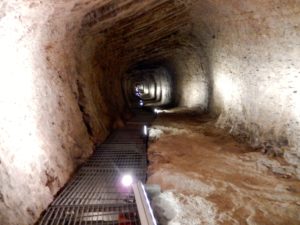EUPALINOS TUNNEL, SAMOS
The Tunnel of Eupalinos or Eupalinian aqueduct is a tunnel of 1,036 m (3,399 ft) length in Samos, Greece, built in the 6th century BC to serve as an aqueduct.

The “Eupalinos tunnel” is a bored tunnel 1036m long. It is estimated that 8-10 years were required to complete the project. The maximum overburden of the tunnel is ~ 170 m below the summit of the Kastro mountain and its elevation is 55m above sea level. The tunnel consists of a corridor having internal dimensions 1.80×1.80m and of a ditch 0.60m wide. The depth of the ditch ranged from 4.0m in its northern section to 8.9m in its southern one. The gradual differentiation of the ditch’s depth provided the necessary longitudinal inclination for the ceramic pipe to convey the water by means of gravitational flow. The ditch itself wasn’t excavated as an open trench at its full length, but portions of it are galleries running underneath the main tunnel.

The majority of tunnel’s length is unlined, although, parts of the tunnel of a cumulative length ~230m were lined with high quality faced hewn stones along tunnel’s section of weak or potential unstable rockmass. Based on the construction technique that was used it could be stated that a ~30m long lined part of the tunnel was constructed in a later stage, during the roman era, with brick walls and an arch shaped roof. Out of the 230m lined tunnel,~18m are at the south entrance of the tunnel. The rest 210m of the lining are at the north tunnel bore towards its exit. The maximum clear height of the lined tunnel is ~170cm and its width is ~65cm.

The astonishing thing about the opening of the tunnel is that the hard limestone was hewn out simultaneously from both sides (north and south), and two crews of stonemasons, working with hammers and chisels, met with almost no deviation from a straight line. Hence, the most remarkable point of the tunnel is the breakthrough (meeting) point of the two excavations. This was done ~170m below the apex of mount Kastro and as proved in the architectural study, it was selected based on a mathematical reasoning. The excavation arrangement there, took into account the possibility of a horizontal and a longitudinal mistake in the excavation directions: the last ~40m of the south bore were constructed kinked eastwards making that way a “waiting wall” for the north bore excavation end to come. The archaeological study has identified seven marking and measuring systems used by Eupalinos to implement the alignment during construction. These systems cover the entire tunnel length and have been deciphered/proved and extensively described in the archaeological study of Hermann Kienast.


